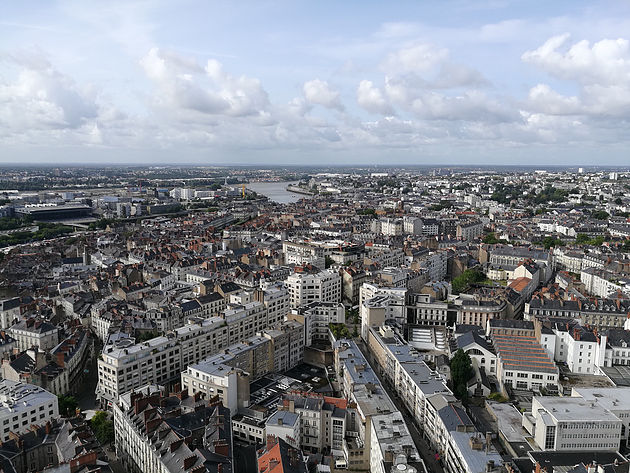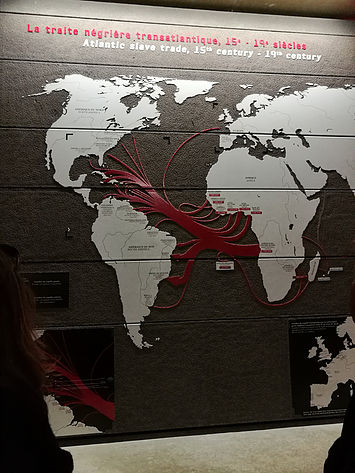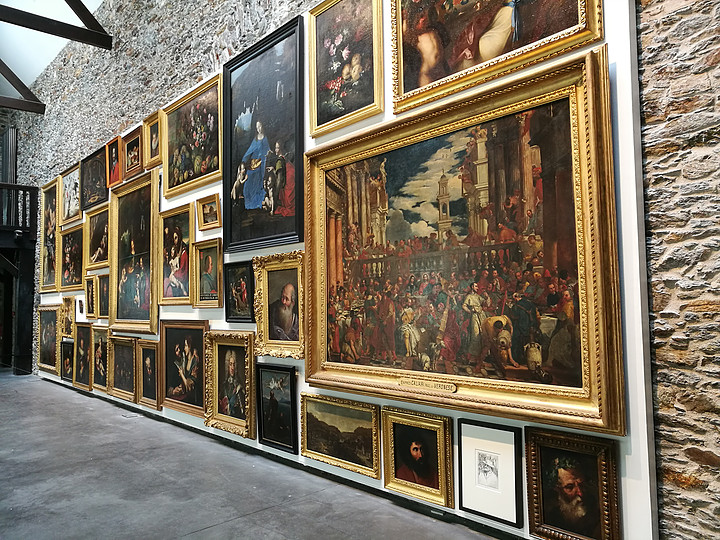Gommalacca Theatre Go&See #2
At the end of this journey in the towns of the French Loire Valley between Nantes and Angers we will return to Basilicata bringing a precious commodity:
art in public space, the role of the artist in a world of active and sentient citizens, des rêves sauvages (wild dreams), the actual "cultural landscape" of people and places, of a widely-looking grey city (Nantes) with an economy made of industrial activities ranging from metallurgical to shipyards, rediscovered as European green capital, symbol of bien vivre, of the ugly turned beautiful because it is finally made visible, understood, valued, politically imagined, loved… and above all "recognized" as a common good.
Nantes, city of Jules Verne, whose Museum watches from above the Loire River as it penetrates the city, and draws the "Ilê de Nantes" river island-in the past no man's land-former railway area dotted with warehouses for the shipyards, reborn thanks to urban redevelopment and which has become: industrial heritage, landscape of contemporary architectural experimentation, unusual space that houses the fantastic machines (mechanical 20-metre-tall elephants, large spiders and rides inspired by Da Vinci), lunar landscapes on which to jump, Cranes repainted and lit up like spaceships, small beaches equipped for barbecues by the river, vast urban vegetable gardens, art galleries, extravagant venues, schools, nurseries, green spaces, socio-cultural centres, and many people, of all ages.
A city that from the 15th to the 19th century was the first point of entrance for slaves destined for France and many other European cities of that era, and that speaks of its past through the "Memorial de l'abolition de l'esclavage", an underground walk along a corridor made of concrete and glass: we find that the names of the ships that transported hundreds upon hundreds of slaves were inspired by friendship, beauty and the Saints: L’Amitié, la Belle Marie, le Saint Paul.
Literally every single part has been thought to welcome the presence of children and all play areas represent great opportunity to express art, curiosity and beauty. Near the Place Mercoeuris a big wooden sea monster, freed from deep sands as told by the author, artist and architect Kinya Maruyama, that puffs steam, offers gymkhanas through its belly, slides along its tongue and "waters" its back decorated with hanging plants. In addition to fountains/pools, Paysage Glissé (slipped landscapes) around the castle of the Dukes of Brittany and numerous artistic interventions of large dimensions that stimulate the city, its residents and visitors.
In the city you just have to simply follow the now famous "LigneVert", the green line drawn on the asphalt along the pavements, pedestrian bridges, iron railings to follow the 52 stages of this year. Every year since 2012 summer in the city is enriched with new visions while keeping past ones alive, including everything up to the delicious Talensac market which displays the art of presenting food.
It is impossible to summarize this trip. We will cite only three works, the ones that impacted us the most, as it is worth considering their meaning.
Mon nom est personne (translator’s note: my name is nobody), exhibition by Alexandre Périgot, a total artist in his use of languages that infiltrates the saturated network of entertainment and art images shaking this mechanism at a standstill by proposing Les anonymes. All museums have a part of anonymous works among their collections. These unsigned works authorize us to tell of various scenarios. An opportunity to look at a work produced between the 17th and 20th centuries, without the presence of the artist, free from panels, signatures, fame and explanations. Man and his vision of the work, a simple and shocking exercise through which we feel the "weight" of a spoiled look.
Entrez Libre by Pick Up production.
A historic jail in Nantes that will be demolished soon. Its external and internal walls portray the mural art of a collective of artists that have given voice to the excruciating suffering of its inhabitants over the years. "To provoke the inner traveller, an invitation to cross the prison bars, its madness, live its saturation". An ephemeral work of dreamlike evasion and magnificent escape.
BLKNTRNTL by Nicolas Darrot.
The Graslin Opera Theatre in Nantes has an immense mechanized black cloth flying slowly on stage. A work designed to connect the outside with the inside. When we discovered it, it was in the foyer of the theatre between the statues of Graslin and Moliére. The code is that of International Black, the first group of anarchists in London at the end of the 19th century. Seen in this way, this approximately 10 metres long flagpole, rhythmically shaken by a mechanism looks mean and vindictive. In the artist’s vision it is the extension of the conductor's baton, and the 45° inclined drape is agitated by simulating the sound of time and reflects the city’s silhouette on the glossy surface. Hypnotic, for us a representation of the ghost of the theatre, dead and buried.

Impossible not to mention Le Lieu Unique, former biscuit factory of le LU (the small butter biscuits more specifically). It is the current benchmark for the contemporary scene of many performative languages, with a brasserie, a library and a hammam downstairs.
All this and much more (the Art Museum, Le Jardin des Plantes, La Tour de Bretagne and the immense stork of Le Nid by Jean Jullien, the Art Nouveau brasserie La Cigale, unchanged since 1845) is Le Voyage a Nantes the public company that has joined the institutions and artistic sites representative of the Ville de Nantes and Nantes Métropole, a cluster of 24 municipalities with a total of 600,000 people that gathers the whole population of the agricultural areas and urbanized areas of the Loire, and which in 20 years has increased the number of residents by 100,000 and expects the same growth until 2030.
A fabulous trip along the 70-km river estuary ensures the discovery of landscapes and collections of contemporary works of art perfectly integrated with the natural resources along the route. Voyage a Nantes is one of the last projects, perhaps the culmination, of a socialist political vision which has used art and culture as a political weapon against their opponents, conceived and designed by current artistic director Jean Blaise, and the current Minister of Foreign Affairs Jean-Marc Ayrault, Prime Minister from 2012 to 2014 and beforehand president of Nantes Métropole.
Nantes is also the city where the Royal de Luxe theatre company is located, in two huge harbour hangars ceded by the city, at 1, Quai Cordon Bleu street.
The artistic director is Jean Luc Colcourt, who in 1996 received the Grand Prix National du Théâtre, the very same received by Ionesco, Beckett, Barroult, Mnouchkine and Anouilh to name a few. To penetrate the fortress means crossing a shipyard to discover the head of a life-size rocket that just came out of a Verne novel, climb several stairs which walls speak of decades of work and of a trip around the world of their productions.
Before meeting the Executive Director GweanelleRaux, with whom all previous contact had been by mail and by phone, I am taken to the "Museum" as they call it. We usually call where all the props are locateddeposits, but theirs are truly special. Indeed,MessieurColcourt had a poetic intuition in 1993, and dropped a giant from the sky. Yes, a giant, a being of wood, machines and cloth wearing a diving suit. It is 15 metres tall and in the costume room I find myself in front of its actual coat. It is hanging on a hanger and starts from the top of the warehouse.
In the dim light I see the feet of the little giant, its niece, and suddenly I cross its eyes, its head is packaged and it looks at me.
Therein lies a life of visions born in principle from Jean Luc Colcourt and Didier Gallot-Lavallée (already starring our first go&seein Rome).
In the days spent in Nantes, after seeing the new show "Les miniatures" twice and having met GwenaelleRaux, the desire to develop the project for which we were selected by the Matera 2019 Foundation grew more and more. To have the possibility of dealing with extraordinary characters means bringing to Potenza and Matera and all of Basilicata giants falling from the sky that tell extraordinary stories of simplicity and poetry made for everyone.
One of the most memorable performances in Liverpool succeeded in attracting 3.5 million viewers.
Colcourt from the beginning chose street theatre because he believed it to be the best way to approach people, subvert reality and inject irony and poetry into the streets, places often neglected or lived daily absent-mindedly. All done following two golden rules: the shows take place outdoors, and are free of charge.
We hope to speak to you about the developments of this dialogue. In the meantime we are preparing for our September-October go&see where we will see giants falling from the Geneva skies.
This trip has allowed us to experience places overturned by cultural operation, a non-invasive artistic dimension in the promotion of events, short and quickly moving queues, a solution that allows us to appreciate the city in a short period of time, to feel it regenerated, from the looks and presence of tourists who really become at this time “cultural residents”, with a European spirit that goes beyond characteristics and "nationalities".
We conclude by saying that without a real political vision no town of Basilicata may really benefit from the arrival of money, relationships, and great artists that Matera2019 will be able to attract.
It is necessary to try to love this land politically, and when we say politically we are addressing administrators and citizens.
To those who open businesses, those who volunteer, to artists, to Mayors and councillors.
Basilicata has an inexhaustible heritage of the past and present, expresses a contemporary soul while remaining deeply rooted to its original characteristics. It is a good thing to finally become politically aware of this. And if the electorate may have to spur our administrators, be aware that ART has an extraordinary power, far more than favouritisms and short-term relations. ART, understood as in all its expressive languages, connects people with each other, improves life, gives hope for the future to the young people of this land. Invest in art not only in oil, wind, and everything else that seems to have a priority, sooner or later everything will dry up, with the exception of man’s imagination.





